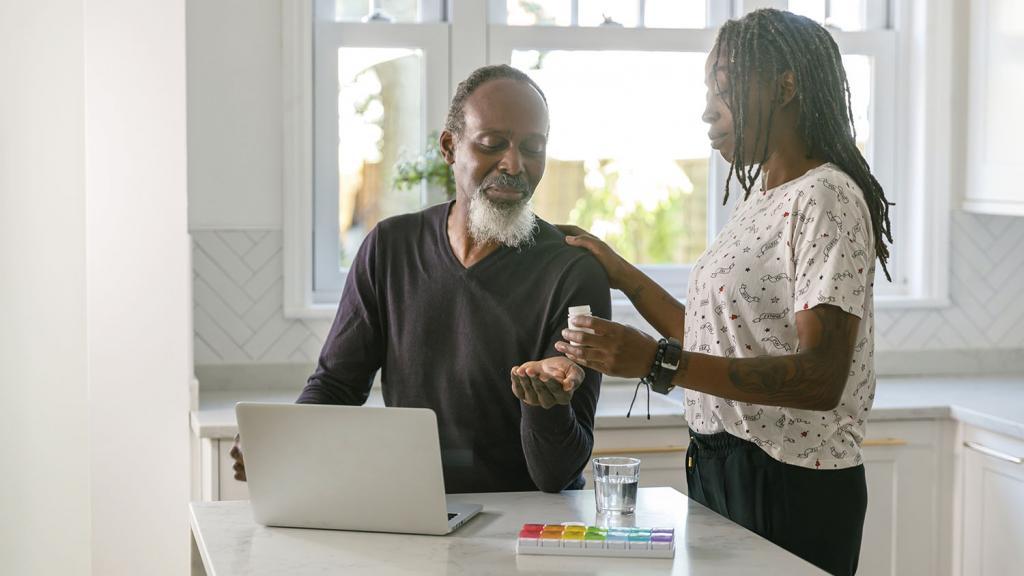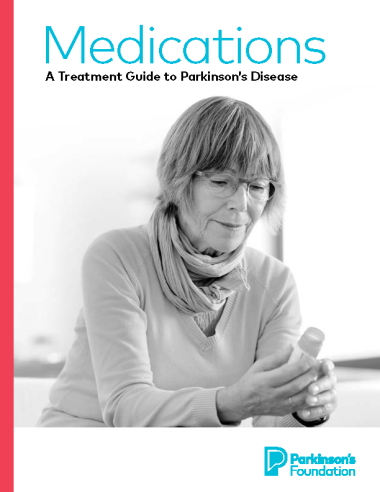The Latest in Parkinson’s Medications: Taking a Personalized Approach

From renowned singer Linda Ronstadt to former NBA player Brian Grant, the faces of Parkinson’s disease (PD) are as diverse as the symptoms. While there can be common themes — such as slowed movement (bradykinesia) or stiffness (rigidity) — each person’s PD experience is unique, making individually tailored therapy vital. Fortunately, the list of medications and treatments that improve quality of life for people living with PD continues growing.
This article is based on a Parkinson’s Foundation Expert Briefing Parkinson's Disease & Medication - What's New presented by Vanessa K. Hinson, MD, PhD, Movement Disorders Program director, Medical University of South Carolina, a Parkinson’s Foundation Center of Excellence.
Parkinson’s disease can vary widely from one person to another. Whether or when someone might experience rapid, involuntary and uncontrollable body movements, called dyskinesias, as a complication of some Parkinson’s medications can also fluctuate. Cognitive changes or multitasking can pose challenges for some who live with PD, while others might experience hallucinations. Optimal PD treatment and care should be based on your unique symptoms and help you to live your best life.
Traditional PD Medications

For a go-to medications and Parkinson’s guide, read our free educational book: Medications.
Although a cure for Parkinson’s has still not been discovered, progressive genetic research is accelerating PD science, uncovering knowledge that may lead to breakthrough therapies. Currently, there are medications and surgical treatments that can improve motor and non-motor PD challenges.
Principal among these is carbidopa/levodopa therapy, the most effective PD prescription. The brain’s chemical messenger dopamine diminishes in PD, causing many of the disease’s symptoms. Carbidopa/levodopa (Sinemet) works to increase dopamine levels. Developed more than 50 years ago, this affordable treatment continues to improve symptoms and quality of life for people who live with Parkinson’s today.
Many established medications to boost the effects of carbidopa/levodopa also exist, as well as alternative therapies, including:
- Dopamine agonists: medicines that imitate dopamine’s action in the brain.
- Monoamine Oxidase Type B (MAO-B) inhibitors: enzyme-breakdown inhibitors that prolong that action of dopamine in the brain.
- Amantadine: long used to ease PD tremor, this medicine has more recently been found to improve the dyskinesia that can often start after years of levodopa treatment.
- Surgical treatments: including deep brain stimulation (DBS), can be helpful for those who experience medication complications or motor fluctuations.
While these standard treatments can enhance quality of life with Parkinson’s, they pose challenges, too, such as motor fluctuations. In particular, levodopa can ease movement and improve function, but can also increase dyskinesia at certain doses as time goes on. Known as “off” times, when medications are delayed or wear off, symptoms return. Other common side effects from traditional PD treatments can include:
- Sleepiness
- Dizziness
- Constipation and nausea
- Cognitive changes
- Hallucinations
- Behavioral changes, including compulsive behaviors like gambling or sexual fixation
A movement disorder doctor can highlight potential benefits and risks, while helping you to find the treatment that works best for you. Good motor symptom management might include one of the above traditional PD medications, or a combination of therapies. Today, several newer treatments can enhance PD therapies and treat a diverse array of non-motor symptoms.
Newer Parkinson’s Therapies
Extended-release carbidopa/levodopa (RYTARY®) has been on the scene for more than five years, yet people are still unaware of its benefits. The capsule may offer longer-lasting symptom improvement for people who experience frequent motor fluctuations.
As PD advances, “off” times can increase. Additionally, some people living with PD can experience gastroparesis (slowed emptying of the stomach). This can make oral medications less effective. Carbidopa/levodopa enteral suspension (CLES or DUOPA™) therapy can lessen motor fluctuations by continuously delivering medicine to the small intestine. This treatment can also lessen dyskinesia. A current clinical research study is exploring how to deliver a similar treatment under the skin using a microneedle.
Levodopa Add-ons
Treatments that complement levodopa can help to minimize motor fluctuations. These include:
- Safinamide (XADAGO®), a once-daily tablet. Similar to rasagiline, this MAO-B inhibitor can reduce “off” times without dyskinesia.
- Opicapone (ONGENTYS®) is a COMT (catechol-o-methyl transferase) inhibitor, like entacapone. Also taken once daily, it extends levodopa benefits and reduces “off” times.
- Istradefylline (NOURIANZ™) blocks dopamine-adjacent adenosine A2 receptors to improve PD symptoms. While safinamide, opicapone and istradefylline can reduce “off” times, they can all potentially increase dyskinesia.
- Another once-daily add-on, an extended-release amantadine formula (GOCOVRI® ER) taken at bedtime, can reduce motor fluctuations and dyskinesia, but can possibly worsen hallucinations in those who experience them. Generic amantadine can also lessen “off” times.
On-Demand Medications
Two newer levodopa add-on medications are designed to quickly ease intermittent, sudden “off” times:
- Levodopa inhalation powder (INBRIJA™) can be administered via inhaler as needed, up to five times a day. It can improve motor fluctuations within 10 minutes and last up to 60 minutes. For some, the powder can cause coughing.
- Sublingual apomorphine (KYNMOBI®) dissolves under the tongue to relieve wearing off episodes for people with PD within 15 minutes, lasting up to 90 minutes. Side effects can include nausea, so treatment may require antinausea therapy. It should be used for the first time in the doctor’s office, as it may briefly induce low blood pressure for some people.
Addressing Dyskinesias
While uncommon in early Parkinson’s, about 90%of people who have lived with PD for 10 or more years will experience dyskinesia. Adjusting medications can help. Sometimes additional medications are required.
One option is the earlier-mentioned amantadine GOCOVRI® ER formula, U.S Food and Drug Administration (FDA) approved to treat dyskinesia. However, it can potentially increase constipation, impact cognition and worsen hallucinations.
Parkinson’s Disease Psychosis
PD psychosis, characterized by confusion, delusions and hallucinations, can be triggered by PD medications, dosages or Parkinson’s itself. Cognitive changes can also be a sign of dementia. These symptoms should be discussed with your doctor.
Medication adjustments can help with PD psychosis, as can clozapine (Clozaril) and quetiapine (Seroquel). A newer treatment, pimavanserin (NUPLAZID®) was approved by the FDA specifically for PD psychosis in 2016.
Low Blood Pressure
Up to half of people living with PD experience lightheadedness, fainting and other symptoms due to neurogenic orthostatic hypotension — a significant blood pressure drop upon standing.
Medication adjustments can help. Medications such as droxidopa (NORTHERA®) may also be beneficial. Droxidopa treats lightheadedness but should not be taken within five hours of bedtime. Headache, dizziness, nausea and fatigue are among the side effects.
Drooling
Decreased swallowing in PD can cause sialorrhea, or drooling. Injectable, FDA-approved therapies can reduce saliva flow. Botulinum toxins XEOMIN® (incobotulinumtoxinA) and MYOBLOC® (rimabotulinumtoxinB) can provide between three to four months of relief.
Tremor-Predominant PD
Deep brain stimulation can improve tremors and motor fluctuations when motor fluctuations aren’t sufficiently controlled with medication. It requires brain surgery.
Focused ultrasound is a minimally invasive surgical procedure that can also improve tremors. An alternative to DBS, it uses high-energy sound waves to terminate a small tremor-related area of the brain. The effects are often immediate. It was approved by the FDA in 2018 for the treatment of tremor-dominated Parkinson’s.
As research continues improving care for people with PD, exercise, a nutritious diet and restorative sleep remain key to symptom management and living your best life.
The Parkinson's Foundation is here for you. Our Helpline has answers to your Parkinson’s questions at 1-800-4PD-INFO (1-800-473-4636) or Helpline@Parkinson.org


